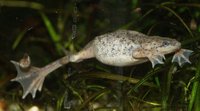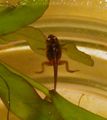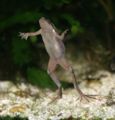Dwarf African Frog (Hymenochirus boettgeri)
From The Aquarium Wiki
(Redirected from DAF)
Dwarf African Frog
Hymenochirus boettgeri
19 Litres (5 US G.)
5-6 cm (2-2.4")
Freshwater
6.8 - 7.8
22 -30 °C (71.6-86°F)
5-12 °d
1:1 M:F
3-10 years
This article discusses something that is commonly mistaken for African Clawed Frog or vice versa. In this case mistaken identification can prove to have disastrous results. See below for details.
Contents
Alternative names[edit]
- African Dwarf Frog (ADF), Dwarf African Frog (DAF), Dwarf Clawed Frog, Zaire Dwarf Clawed Frog, Eastern Dwarf Clawed Frog, Gaboon Dwarf Clawed Frog, Western Dwarf Clawed Frog, Marble Frog, or Dwarf Clawed Frog.
Synonyms[edit]
- Hymenochirus curtipes
History[edit]
- Family : Pipidae
- Dwarf African Frogs were discovered by Tornier in 1896 and were first classed as Xenopus boettgeri.
- This was later reclassified into its own Genus Hymenochirus.
- However, it wasn't until 1996 that it was given a common name of Dwarf Clawed Frogs by Norman Frank and Erica Ramus, in the publication A Complete guide to Scientific and Common Names of Reptiles and Amphibians of the World.
Synonyms[edit]
- Xenopus boettgeri - Tornier, 1896
- Hymenochirus feae - Boulenger, 1906
- Hymenochirus boettgeri feae - Perret and Mertens, 1957
- Hymenochirus boettgeri - Tornier, 1896
- Hymenochirus boettgeri boettgeri - Perret and Mertens, 1957
- Hymenochirus boettgeri camerunensis - Perret and Mertens, 1957
- Hymenochirus boulengeri - Witte, 1930
- Hymenochirus curtipes - Noble, 1924
- Of these species only Hymenochirus boettgeri and to a much lesser degree, Hymenochirus curtipes are found in the Aquarium shops around the world. But it is suspected that most are hybrids of the two.
Sexing[edit]
- Male DAFs tend to be smaller, and develop a small red or white spot behind their armpits when sexually mature. When viewed from above, they have a V shape ridge across the back from the anus across the rear legs (see picture below). The males also have a tiny, hardly visible 'tail' bud.
- The females are far rounder in appearance, and have a small tail bud.
- The males also sing, while the females only sing rarely and usually only as a response to the male.
Tank compatibility[edit]
- The DAF will not bother any fish bigger than itself. It will, however, eat fish fry. It has been reported that DAF are compatible with larger shrimp such as Amano Shrimp. Along with this, some owners keep them with snails such as the Golden Apple Snail. They may, however, occasionally try to eat the eyestocks of snails thinking they are food. Two animals not compatible with DAFs are crayfish, and crabs.
- Some people keep DAFs with Betta splendens. This is difficult, as Bettas are also carnivores, so they compete for the same types of food. Often the Betta gets fat whilst the frog starves. Along with this, Bettas and DAFs have been reported to nip at, attack, and ultimately injure each other.
- Other than this, DAFs are generally pretty docile creatures, and any accidental nips tend to be caused by their clumsy eating habits rather than agression.
Diet[edit]
- A carnivore with an affinity for scavenging, these frogs will normally eat insects, worms, and small fish fry in the wild. In captivity, the DAF can be fed on pieces of raw fish and meat, such as tuna steak, beef heart (though only feed this once a week), and tilapia or salmon. It is also common to feed the DAF prepared foods such as thawed blocks of frozen Bloodworm (though only once or twice a week as its low in nutrients), Brine Shrimp, small Earthworms or Whiteworm, TetraPrima, ReptoMin, and small cooked pieces of mussels or prawns and catfish pellets. Some pellet food may appear unappetizing to the frog due to its lack of movement, and many frogs have different preferences. Some frogs will happily consume pelleted food, while others tend to ignore it, instead preferring frozen or live.
- Most pet stores don't seem to be aware of the correct food to provide for these animals. The DAF often has little to no interest in flake or pelleted food, instead preferring thawed frozen food or live food.
- It is said the DAF's favorite food is beef heart. Only feed this as a treat.
- Do not feed these frogs any raw fish meat that contains Thiaminase.
Feeding regime[edit]
- Feed once a day when young, feed once every two or three days when over one year old. A DAF can go four days without food in case of emergency. Whilst adult DAFs should not be thin, don't let your frog get too fat! Bloating and obesity can easily occur in generously fed DAFs.
- DAFs have no teeth (and no tongue), so they need food that is either small enough to eat whole, or can be broken up by violent sideways jerking motions. Freezing meaty food before hand is an excellent method of breaking down the tough fibres so it easily breaks up.
- Bloodworms are often suggested to owners as a DAFs main food source. This is a very bad idea for a DAF, as this food source is low in protein, and lacks many essential amino acids the frog requires to live. Feed bloodworm sparingly. Variety is the key.
- If they are kept with fish they will often either need to be target fed, or fed using a DAF feeder.
Environment Specifics[edit]
- This is a fully aquatic frog and will stay underwater for hours; however, it still needs to periodically come up to the surface to breathe. The substrate must be too large or (preferably) too fine to be eaten by the frog while lunging for its food.
- If gravel is eaten by the frog, it will remain in the intestinal tract, cause blockage, and shortly afterwards, death. Sand or river rocks of at least 0.5cm (0.2") in diameter is recommended. The minimum tank size for one adult frog (over a year old) is 19 Litres (5 US G.). A young frog can probably get away with 11 Litres (3 US G.). Biological filtration perhaps isn't needed if the owner keeps up with regular weekly water changes. But it helps keep the levels of ammonia down if the owner neglects, overstocks or overfeeds.
- If it happens to be a power filter with a intake pipe, cover it with fine mesh to prevent the trapping of the frogs' delicate legs causing it to drown. This is a common occurrence in larger tanks.
- The water level must be dropped 2.5-5.1cm (1-2") from the top for two reasons; one, to allow for proper gas exchange and respiration of the frogs, and two, to prevent escape and therefore death. Otherwise ensure there are no escape holes for the frogs to explore. A DAF can easily jump 7.6-10.2cm (3-4") into the air from a solid base.
- These frogs cannot be out of water for more than 10-15 minutes. If they somehow escape into the relatively desolate environment of an average home, their skin will dehydrate, and they will die.
- These frogs can be easily kept in aquariums with a tall water column. A -43cm (18-24") tall tank is not a problem for them.
- DAFs particularly enjoy having tanks with live plants, leaf litter, and secluded places in which to hide.
Origin[edit]
- This animal inhabits forested equatorial Africa from Nigeria and Cameroon south through Gabon and east throughout the Congo River Basin.
Behaviour[edit]
- DAFs are peaceful animals known for their 'comical' behaviour.
- The DAF, like all frogs, have to discard their outer layer of skin every few weeks as they grow. They accomplish this by twisting and turning violently, and often go on to eat the skin.
- Young and juvenile DAFs tend to be more active near the water line, and prefer floating plants to lie upon. This allows them easier access to oxygen from the water's surface.
- The DAF is very long sighted, as adults have eyes on opposing far sides of the skull. This means it has great difficulty in seeing anything close to it or directly in front of it, so it relies on its sense of smell and vibration to find its food. It can often be seen lunging at food on the bottom, missing quite a few times! DAFs can be very clumsy eaters, often nipping everything that moves around them until one of those things is food.
- It can take a DAF around ten minutes to discover that there is food in the tank. Because of this, if a DAF is kept with bottom feeding fish, you have to allow for this by feeding the fish first in one place, and then feeding the frog in another place. It can be all too easy for a inexperienced owner to starve their frogs if kept with bottom feeding fish.
- The male frog makes a low long repeating chirping sound to attract a mate (The female makes a similar if shorter reply). This can be heard if you have the tank in a quiet room and you listen at night at least 1 to 2 feet away. It's said this is a good sign your frog is healthy, and content.
- See external link below for a MP3 sound file of the male.
Breeding[edit]
- Most frogs require a trigger to get the female to produce eggs. The Dwarf African frog is no exception.
- Gradually drain the tank water level down to around the 7cm (2.8") level over a period of 2 to 4 weeks.
- Then suddenly increase the water level back to normal using warm water so that the temperature of the water is increased to 28-30°C (82.4-86°F) and keep it there for 2 weeks. Ensure the frogs get enough high quality food (not just bloodworm). This should trigger the females frogs into generating eggs and will soon look noticeably fatter.
- Once the female is ripe with eggs the male will grab her in a lumbar amplexus and begin the spawning dance. This consists of holding on to the female for many hours and if the female is receptive she will repeatedly swim and dive to and from the surface in a circular motion and release floating eggs near the surface and the male will release his sperm to fertilise them.
- As many as 750 eggs may be released and these tend to scatter across the aquarium. The frogs may eat the eggs, so remove the adults. The eggs will hatch after 2-6 days and the 4mm tadpoles are carnivorous and will require high concentrations of infusoria and microscopic protozoans if they are not to starve.
- After a few weeks the tadpoles will be large enough to eat whiteworm, baby brine shrimp, Cyclop-eez, etc.
- Six weeks after hatching, the tadpoles will metamorphose into small frogs about 14mm long.[1]
Identification[edit]
- The DAF can be distinguished from a young African Clawed Frog by the fact that the DAF has webbed fingers. The ACF does not. Also there is no albino version of the DAF on sale currently.
- Telling apart a H. boettgeri from a H. curtipes isn't easy as the two species can interbreed to create a hybrid. Some breeders believe that the DAF sold in the Trade is such a hybrid.
- H. curtipes has a shorter head with smaller eyes, its skin is covered with tiny bumps which are larger and more distinctive than the same bumps on a H. boettgeri. It has shorter hind legs than H. boettgeri It may also be lighter in colour.[2]
- H. curtipes also has tubercules (warts) on its upper hind legs which are the same size as on its back. Where as H. boettgeri has tubercules on its upper thighs which are larger than on its back.[3]
- See image below.
Special Notes[edit]
- In America and Canada most large chain shops are selling these frogs infected with Chytrid Fungus, a highly infectious and deadly fungus which kills within the first 3 months of ownership. This is believed to be due to the shops mixing the African Clawed Frog (which is a immune carrier) in with the dwarf frog and so passes on the fungus via the water. It is recommended that owners in these countries quarantine their new frogs for no less than 3 months before placement in their main tank. See our Chytrid Fungus article for more details.
- Life Span - In the Yahoo Dwarf African Frogs group there are several members who claim their DAFs had lived for 10 years.
Pictures[edit]
- Picture of a wild Hymenochirus curtipes
Video[edit]
| Young DAFs at feeding time | Two Adult DAFs (one 'white') |
| Very young DAFs | Adult male and female mating |
| Frog eating raw Tilapia fish flesh | Frog eating TetraPrima pellets |
| Frog eating Bloodworm | Frog eye movement on feeding |
External links[edit]
- General Frog Health (Archived Link)
- Treatment for Dropsy, Balloon Disease (Endolymphatic hydrops) or Water oedema
- PetCo Care Sheet (PDF)
- Yahoo Discussion Group on DAFs
- Google Video of Female DAFs
- Two young DAFs on Google Video
- Google Video of young DAFs
- Amphibiaweb on Hymenochirus boettgeri
- Amphibiaweb on Hymenochirus curtipes
- An extract of 'On the behavior and breeding biology of the African pipid frog Hymenochirus boettgeri'
- PFK Article - Dwarf & Clawed Frogs
- Aqualog Mini book - My Dwarf Clawed Frog by Frank Schafer, Burkard Migge. Publisher: Verl. A.C.S in 2003, ISBN 3936027307, 9783936027303 - Search for copies
Breeding Links[edit]
- African Dwarf Frog Breeding
- Dwarf Frog Central - Breeding and tadpole identification.
- Making infusoria for your tadpoles
- Raising tadpoles
References[edit]
- Amphibian Species of the World and their species names
- Gabon
- Cameroon
- Species Literature
- Paperback - Complete Guide to Scientific and Common Names of Reptiles and Amphibians of the World
- Discrepancies in Observations of Hymenochirus boettgeri, Rabb vs. Sokol by David D. Cecere.
- ↑ Breeding reference: Amphibians in Captivity by Marc Staniszewski 1995. ISBN 0-7938-0133-8, pub. TFH Publications Inc.
- ↑ Rabb, G. B. and Rabb, M. S. (1963). On the behavior and breeding biology of the African pipid frog Hymenochirus boettgeri. Zeitschrift für Tierpsychologie, 20(2), 215-241. 1963
- ↑ Frank Schafer - My Dwarf Clawed Frog. Aqualog Minis. ISBN 3-936027-30-7 page 5. pub.2003










